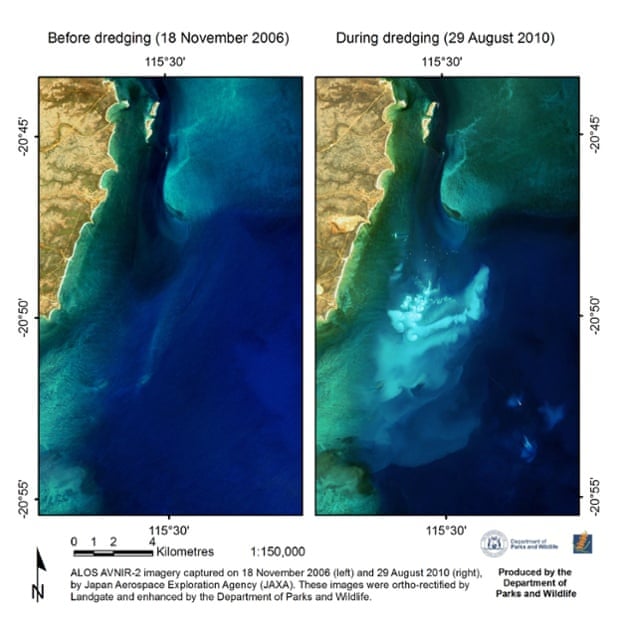Coral reefs face heightened risk of fatal disease from dredging, says research
Coral faces a heightened risk of fatal disease if the seabed near it is dug up, according to a landmark study that will reignite the debate over whether dredging projects near the Great Barrier Reef should take place.
The research, conducted by the ARC Centre of Excellence for Coral Reef Studies and the Australian Institute of Marine Science, found that dredging near coral reefs doubled the frequency of diseases afflicting corals.
The study, the first of its kind to directly address the issue of dredging and coral health, is likely to raise further questions over whether a plan to dredge 3m cubic metres of seabed and dump it within the Great Barrier Reef marine park is a wise one.

Analysis of corals subjected to plumes of seabed sediment found that they were two times as likely to suffer a myriad of different diseases, compared with those untouched by dredging. Worryingly, these affected corals were most likely to suffer from “white syndrome”, a condition that effectively destroys them.
“White syndrome is like if your flesh fell off at the fingertips leaving just bone, and then kept going on up your arms and then the rest of your body,” Joe Pollock, lead author of the study, told Guardian Australia.
“When you have bleaching events, which cause the corals to go white, you can still get some recovery there because the coral is still alive. But with white syndrome the tissue is completely gone and it won’t recover at all.”
Researchers studied the progress of an 18-month dredging project near Barrow Island, a previously pristine area off the Western Australian coast. The dredging involved the removal of 7m cubic metres of seabed to create a channel to accommodate ships for the Gorgon natural gas project.
Using satellite imagery, researchers could map the areas of coral covered by plumes of sediment released by the dredging process. They found there was a “direct link” between coral disease and sediment.

Corals require both food and light to survive. Dredging creates turbidity in the water that reduces the amount of light reaching the coral, affecting photosynthesis, while silt that settles on the coral interferes with its ability to feed itself.
“The sediment clogs their mouths up,” Pollock said. “The coral can shed sediment, but it’s very energy intensive. When the coral is expending a lot of energy, at a time when it is getting less energy from the sun, it becomes very stressed.
“A doubling in disease is substantial. The issue is that these diseases are chronic – we only saw a snapshot but I’ve rarely seen these white syndrome diseases stop progressing. They can kill 2 to 3m-wide corals, like the ones we see on the Great Barrier Reef, within a few months.”
On top of an increase in these devastating diseases, the study found there was a ninefold rise in other signs of compromised coral health, such as bleaching and sediment necrosis, when the corals become smothered in seabed spoil.
The federal government has already approved a plan to expand theQueensland port of Abbot Point by dredging the seabed and dumping the sediment within the Great Barrier Reef marine park.
Significant questions remain over the project, such as its cost and also how far plumes of sediment will travel once the spoil is deposited back into the water. North Queensland Bulk Ports, the project’s proponents, have still to identify an exact location for the dumping site, after the first choice was deemed unsuitable.
NQBP and the government both insist the dredging will be done safely, with minimal impact to the environment. A slew of conditions are attached to it, such as the stipulation that dredging is only undertaken between March and June each year, to protect spawning coral.
But environmental groups say the dredging will add significant pressure to a reef already suffering from pollution and a plague of coral-eating starfish. The North Queensland Conservation Council has launched a legal challenge against the project.
“It’s important we get our heads around these impacts, so we can make the right decisions,” Pollock said. “Dredging is part and parcel of these development projects. We don’t argue that these should be stopped, but you need to understand the impact so it’s done in a sustainable manner.”
Comments
Post a Comment